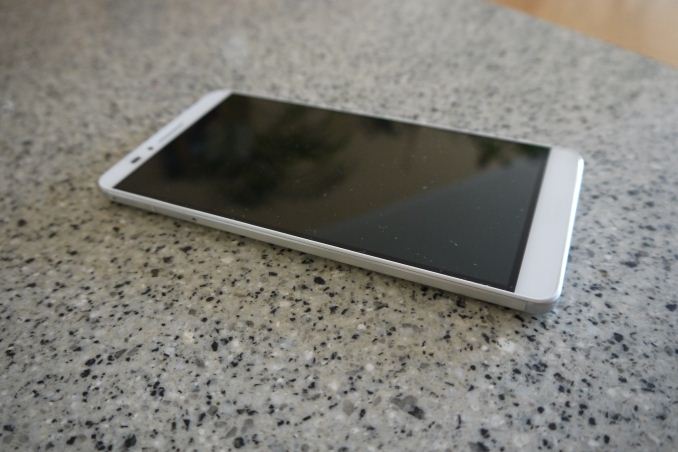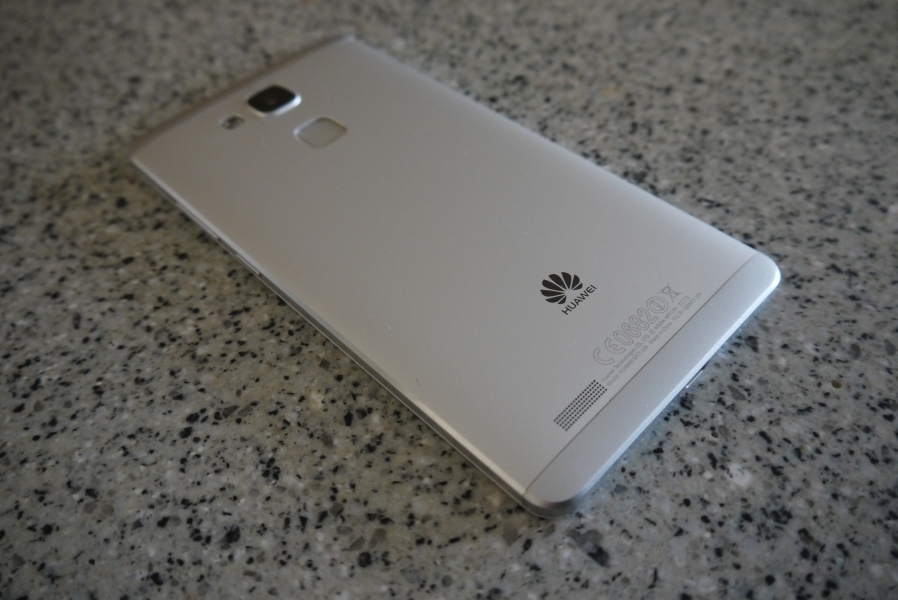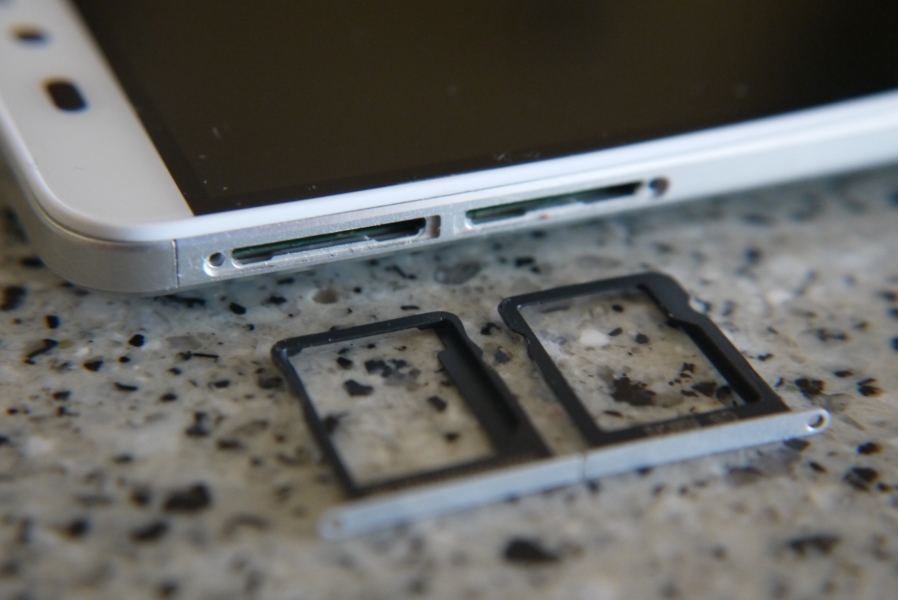The Huawei Ascend Mate 7 Review
by Andrei Frumusanu on December 2, 2014 8:00 AM EST- Posted in
- Smartphones
- Huawei
- Mobile
- Ascend Mate 7
- HiSilicon

It's been a while since I got the Mate 7 at IFA in Berlin and I have been using it on an off since then. As a new member of the AnandTech crew I still had to get the proper equipment to be able to go through our test bench on my own. After lots of delays for which I apologize, we finally take a thorough look at the Huawei's new flagship.
Huawei's been launching new devices at great speed this year. The Ascend Mate 2, which is the Mate 7's literal predecessor was only released earlier in the year, but came only as a more mid-range specced device with corresponding price-tag. Huawei has been gearing up and is now targeting the high-end to try to gain marketshare from other established manufacturers such as Samsung, HTC and Apple.
| Huawei Ascend Mate 7 Specifications | |
| SoC | HiSilicon "Kirin 925" Hi3630 (4x A7 @ 1.3GHz & 4x A15 @ 1.8GHz, Mali T628MP4 @ 600MHz) |
| RAM/NAND | 2/3 GB LPDDR3-1600, 16/32GB NAND + microSD |
| Display | 6” 1920x1080 JDI in-cell LTPS 373PPI |
| Network | HiSilicon Balong LTE Cat. 6 300Mbps CA modem (SoC integrated) Network frequencies (MT7-L09, MT7-TL10, European models): FDD B1/2/3/4/5/7/8/20/28, TDD B40 |
| Dimensions | (H) 157 x (W) 81 x (D) 7.9mm, 185 grams |
| Camera | 13MP Sony BSI sensor, F2.0 aperture, ISP 5-piece lens 5MP front camera |
| Battery |
4100mAh (15.79 Wh) rated |
| OS | Android 4.4.2 "EmotionUI 3.0" 3.10.33 Linux Kernel |
| Connectivity | 802.11a/b/g/n Wifi + BT 4.0, USB2.0, GPS/GLONASS, FM radio |
| SIM Size | MicroSIM + NanoSIM |
| Price |
(MT7-L09) 2GB RAM/16GB ROM : 499€ |
The Mate 7's most differentiating factor here is the use of Huawei's subsidiary HiSilicon Kirin 925 in-house SoC. If you've been closely following this SoC you will know that I took an in-depth look into this chip in the review of the Huawei Honor 6. I recommend re-reading the SoC page to freshen up yourself on the more intricate details of the silicon, as the Mate 7 employs the same chip with only a slight speed bump on the CPU. In fact, the HiSilicon Kirin 925 seems to be a re-named Kirin 920, as both chips sport the same Hi3630 model number internally. As such, it offers the same fundamental capabilities as the 920: an ARM big.LITTLE design with a quadcore A7 at 1.3GHz and a quadcore A15 at a slightly raised 1.8GHz. Graphics capabilities is delivered by an ARM Mali T628MP4 GPU running at 600MHz, so no change over the Kirin 920.
Again, connectivity is provided by HiSilicon's own integrated Balong LTE Cat. 6 modem. I've mentioned in my review of the Honor 6 that I couldn't test the modem at all due to receiving a Chinese variant only compatible with TDD LTE and TCDMA frequencies and was limited to 2G only. Luckily, the Mate 7 supports a very wide range of frequencies which should make it compatible with all European networks, supporting bands B1/2/3/4/5/7/8/20/28.
The 16GB model priced at 499€ comes with 2GB of LPDDR3-1600 RAM, while the more expensive 599€ priced model offers 32GB of eMMC storage with 3GB of RAM. Power is provided by a large 4100mAh / 15.79Wh embedded non-replaceable battery.
In terms of design and build quality, this is Huawei's best attempt to date. The Mate 7 comes in a mostly aluminium frame which covers its sides and most of the back. We find plastic covers at the top and bottom on the device, undoubtedly the RF windows used for the antennas of the various networking components. There is a single large speaker on the lower of the phone, which performs surprisingly well, as it offers a deeper and louder output than the Note 4 which employs a similar design.
The front glass panel is surrounded by a plastic coasted metal rim on the very edges. On my white model, this made for an odd contrast with the metallic look of the sides and back of the device, the black model that I took some photos of back at the announcement which you can see here is definitely a more attractive variant. I'm not too sure why Huawei opted for this plastic coating, as it can be easily damaged during a fall and expose the underlying metal, as a full sturdy plastic rim would have been more sturdy.
With a 6" 1080p display the Mate 7 is well into the phablet category of devices. The dimensions figure at 157 x 81 x 7.9mm, making this one of the biggest phones out there and easily matching the Nexus 6 in terms of footprint. The 185g weight is also something to consider - in my subjective opinion this is an aspect of phablets that gets overlooked easily, and can easily be a negative point for everyday usage.
On the top back of the phone we have a raised camera bulge, encasing the Sony IMX214 module. A strong LED flash accompanies the camera. There is a thin slip of plastic coming from the top of the phone towards the camera module separating the aluminium back, this is done as to enable NFC to work through the metal design.
Finally, under the the camera we find the fingerprint sensor. This is a touch-sensor manufactured by Swedish company FPC, which may be the FPC1020 that was announced late last year. As such, Huawei is the first manufacturer following Apple's TouchID to offer a full touch sensor as opposed to a swipe implementation as found on Samsung's devices. It offers full 360° print rotation readout support, no matter if you have wet fingers or not. Huawei implements a RF sensing ring around the sensor that makes it possible to detect your finger even when the device is sleeping (as it will wake the device up). This allows for turning on of the device and unlocking in a single action. I've found the success-rate of the sensor to be extremely high, but only as long as you center your finger well on the sensor area, as I have the impression the sensor itself is much smaller than what the design makes you believe.
One thing I found very odd and unsatisfying is that the USB 2.0 port on the bottom isn't actually symmetrically in the middle of the device, but slightly to the left. A strange design decision that may have been result of technical limitations in internal layout of the phone.
On the right side of the phone we have the volume and power buttons in a comfortable and reachable height, the buttons are made out metal and offer good tactility. On the left side, we find two ejectable trays which hold, for one, a microSIM, and in the other, both a microSD and a nanoSIM. The design of the second (bottom) tray is quite innovative in that regard. A SIM eject tool comes packaged with the phone.
Overall, the Mate 7 is an attractive device with good build quality. Due to the thinness of the device it's not as uncomfortable as you might expect it given the size. I definitely prefer the black model as it gives it a more sleek look than the white plasticky front of the white one.
Next, let's view Huawei's new take on Emotion UI, introducing version 3.0 of the Chinese manufacturer's Android interface...


















72 Comments
View All Comments
Laststop311 - Tuesday, December 2, 2014 - link
Wish we could have some american phones with battery life like this.arsjum - Tuesday, December 2, 2014 - link
Andrei,Any chance you'll be reviewing Galaxy Note 4 exynos version?
Andrei Frumusanu - Tuesday, December 2, 2014 - link
I've been working on the article for 2 weeks, it's coming.DanD85 - Tuesday, December 2, 2014 - link
Thanks for reviewing this Huawei phone, anandtech. These days, Chinese manufacturers have much more interesting devices compare to the old players. Anandtech has been my favorite tech review site for more than 10 years and you guy offer the most in depth review on the whole interweb. Keep up the great work!Sicariase - Wednesday, December 3, 2014 - link
Seriously Andrei, thanks for this review. I've been tossing up between the note 4 and this for a couple of weeks, and just decided to get the huawei (didn't think the differences were massive from other reviews) when this review came out. You've potentially saved me from a world of disappointment.Bondurant - Wednesday, December 3, 2014 - link
As with other reviews on this site, the problem in this review is that there is no corresponding reference to real life usage. Just lots of numbers but for example why not a real life gaming comparison between Mate 7 and Note 4 ? NAND performs horrible in benchmarks but if in real life there is barely any noticeable change, than does the benchmark score even matter ? How about comparing the photos with other 13MP IMX214 phones ? Also frustrating i found is there is no explanation as to what exactly is the cause of poor battery performance of Mate 7, is it the fault of GPU or their modem or that it does not use a amoled screen like Note 4 ? Is it a fixable issue with rom updates ?Ofcourse ideally Huawei could have simply thrown in some Qualcomm and so on like Samsung does, but it prevents the development of Hauwei's own innovations and implementations. HiSilicon from its last year K3V2 to this years Kirin 925, there is huge improvement and they are already releasing their 64bit chip kirin 930 this December and a Kirin 950 in June.
Andrei Frumusanu - Wednesday, December 3, 2014 - link
Basically the cause of bad battery life is that power consumption of the Kirin SoC is too high - I've explained this in the review of the Honor 6 where I took an in-depth look into the chip.Bondurant - Wednesday, December 3, 2014 - link
But a comparison between Honor 6 and Samsung S5 (both the Qualcomm and Exynos version) battery life don't show Kirin SOC having such suspected high battery drain problem, although yes you did mention ways battery life could have been improved but nothing to say of a huge problem.The case with Mate 7 on the other hand with 1000mAh more battery than Honor 6 does seem weird that the battery life improvements are only marginal.
Andrei Frumusanu - Monday, December 8, 2014 - link
I did point out that the Honor 6 is less efficient than competing devices.johnny_boy - Thursday, December 4, 2014 - link
Are you serious? I own an Honor 6 and I'm getting two days of battery life under normal usage (YouTube, Gmail, Gcal, pdf reading, etc.) Under light usage I can get 2.5-3 days. This is with wifi on and auto half brightness, which I find comfortable. I'm even using Firefox for Android with adblock for browsing which is likely worse on the battery than Chrome. Some REALISTIC battery life numbers would be pretty useful--like how long were you getting under what you deem light/normal/heavy usage?